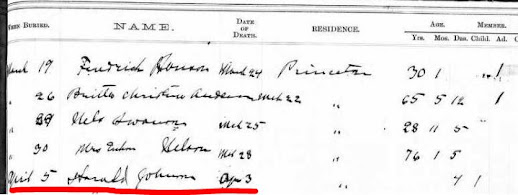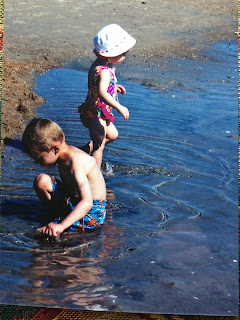In
researching my paternal grandmother, Edna Johnson Peterson, I found a new
relative in the 1900 census: Annie T.
 |
| 1900 US Census, Princeton, Bureau County, Illinois |
This is the Johnson family in Princeton, Illinois, in 1900. According to the census, little Annie was born in November of 1898 so she was one and a half when the census was taken. She was the third daughter of her parents, Anna and Theodore Johnson. (Another daughter named after her mother!) I had never heard of Grandma’s older sister Annie. My grandmother Edna had not yet been born; did she even know about Annie? I wanted to know more about this little girl!
The
1910 census held another clue and prompted more questions. Annie was not listed in this
census, although my grandma Edna was there along with her younger sister Evelyn and
two older sisters Myrtle and Laura. Here’s the notation that sent me digging
deeper:
 |
| 1910 US Census, Princeton, Bureau County, Illinois |
Annie Johnson, mother, was asked how many children had been born to her and how many children were now living. She had had 6 children and 4 were now living. She had lost two children in the past decade.
I
went to the records of Princeton’s First Lutheran Church, the Swedish Lutheran
church that the Johnsons were members of. In 1898 I found little Annie’s birth
and baptism record, and in 1901 the sad record of her death.
| 1898 baptism record, First Lutheran Church, Princeton, Illinois |
| 1901 death record, First Lutheran Church, Princeton, Illinois |
The Princeton newspaper provided one more piece of the puzzle. Little Annie had died of pneumonia. I have not yet discovered where she is buried.
 |
| Princeton Bureau County Tribune, 26 April 1901, page 4 |
Other questions remained. According to that 1910 census notation, there had been another child. I went back through my records and reread Annie Johnson's obituary, which is amazingly detailed. Here's what it said:
 |
| Bureau County Tribune, 7 June 1945, page2 |
Annie
and Theodore had had a son.
I
went back to the church records.
 |
| 1905 baptism record, First Lutheran Church, Princeton, Illinois |
 |
| 1905 death record, First Lutheran Church, Princeton, Illinois |
Harold Raymond Johnson. A little boy, who lived 4 days. Born and baptized on the same day, did you notice? I don’t have any newspaper clipping or a death certificate to tell my why he died. But I imagine he spent those four days in his mother’s arms as she nursed him, bathed him, loved him, and ultimately said good-bye to him.
Harold.
Annie. My grandma’s brother and sister, two relatives I had never heard about
and never known. I wish I had pictures of the little darlings, I wish I knew
more about them. These little ones were indeed gone too soon, but not too soon
to be loved by their parents and family. Even if Anna and Theodore never spoke
of Annie or Harold after their deaths, they surely remembered them. Now we can
remember them, too.


































